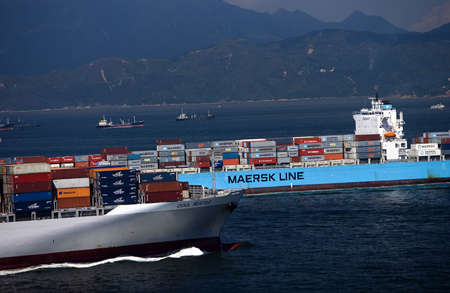-
News >Bizchina
Largest-ever cargo ships are ordered
2011-02-22 13:51
Maersk plans to carry goods to and from China in the massive vessels
An A.P. Moller-Maersk AS container ship leaves Hong Kong. [Photo / Bloomberg News]
HONG KONG - Driven by the growing demand generated by China's booming economy, AP Moller-Maersk AS, one of the world's biggest container shipping lines, has signed a $1.9 billion contract with South Korea's Daewoo Shipbuilding & Marine Engineering Co Ltd to build 10 of the largest-ever cargo-box ships, said Tim Smith, the chief executive officer for the company North Asia region.
The new vessels will be designed to carry 18,000 containers each, enough to fill Times Square in New York, and are scheduled for delivery between 2013 and 2015, the company said on Monday. They will be specifically used for transport between Asia and Europe, the Danish company said.
The contract also includes rights and options for another 20 ships, which brings the cost of the entire deal to about $5.7 billion, the largest order in history, Smith said.
"We consider it an opportune time to order these new vessels as the annual market growth for Asia to Europe (westbound) trade is expected to be in the range of 5 to 8 percent during 2011 and 2015," he said.
"The new tonnage will support our efforts to maintain our current market share," he added.
As China gradually emerges as one of the main engines of world economic growth, recent years have seen Maersk increasing its fleet numbers for transport to and from the country.
"China is the biggest container-shipping market and it is very important for us. In a way, these new ships are specifically planned for China," said Soren Karas, head of the company's Hong Kong-based South China cluster.
Currently, the company has the largest market share of any container-shipping line in this trade, moving 18 percent of the container cargo from Asia to Europe and 15 percent of the container cargo traveling from Europe to Asia.
Two-thirds of the cargo between the two continents goes to and from China, the company said.
The new vessels, 400 meters long, 59 meters wide and 73 meters high, will be the largest ships of any type on oceans. The capacity of 18,000 containers is 16 percent greater than the largest container vessel currently operating, the Emma Maersk, which is also owned by the company.
The new ships were named Triple-E class to emphasize the technological advances: economies of scale, energy efficiency and environmentally improvements, as they claim to produce 50 percent less CO2 for each container moved than the industry average on the Asia-Europe trade lane, and consume approximately 35 percent less fuel for each container than 13,100 container vessels.
According to the company, the new ships will touch the five large-scale Chinese ports; Shanghai, Ningbo, Xiamen, Yantian and Hong Kong, and will further the company's dominance in the trade by adding significant capacity.
Karas also said the new ships are expected to increase Chinese ports' experience in handling giant ships, and the company is now engaged in dialogue with major Chinese ports to plan the arrival of the new vessels.
"Chinese ports are in a very good position to receive the large vessels, and we believe they will quickly learn how to handle large-scale ships," he said.
However, Maersk's move has prompted doubts about the prospects for global trade, including the question of whether China's growing demand can be maintained as the authorities implement a tightening monetary policy to contain the country's stubbornly high inflation rate.
Clarkson, the world's largest shipping research institute,predicts that worldwide container-shipping demand may increase 9.7 percent this year as the global economy emerges from the financial recession.
"A large portion of the industry is not yet convinced this is the future trend for the market," Teddy Tsai, shipping analyst for DnB Nor Markets in Singapore, told Reuters.
The Baltic Exchange's main sea-freight index, the gauge of the costs of shipping commodities, registered an upward trend in February after experiencing a steady decline between October and January.
In China, the Consumer Price Index jumped 4.9 percent year-on-year in January, close to November's 28-month high of 5.1 percent, according to the Chinese National Bureau of Statistics.
On Friday, the required reserve ratio for Chinese banks' was raised by 50 basis points, the eighth hike since the start of 2010, and Governor of the People's Bank of China, Zhou Xiaochuan, said that further interest rate rises to tackle inflation have not been ruled out.
